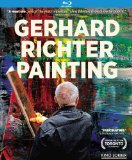| Reviews & Columns |
|
Reviews DVD TV on DVD Blu-ray 4K UHD International DVDs In Theaters Reviews by Studio Video Games Features Collector Series DVDs Easter Egg Database Interviews DVD Talk Radio Feature Articles Columns Anime Talk DVD Savant Horror DVDs The M.O.D. Squad Art House HD Talk Silent DVD
|
DVD Talk Forum |
|
|
| Resources |
|
DVD Price Search Customer Service #'s RCE Info Links |
|
Columns
|
|
|
Gerhard Richter Painting
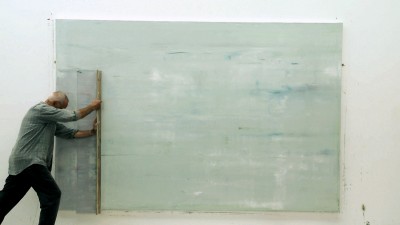
Please Note: The images used here are taken from stills provided by Kino Lorber, not the Blu-ray edition under review.
"Watching paint dry" is the go-to cliché when we're searching for a way to verbally illustrate our boredom with a movie or other experience we find dull, but painting itself makes, oddly enough, a captivating subject for a movie. That's painting, not necessarily painters; as good in their way as Pollock or The Horse's Mouth or Vincent and Theo are, there's something uniquely cinematic, particularly special about watching an artist revealed not through their life story, but through seeing them in the very act of creating their art: Think of Nick Nolte's practically carnal paint-splattering and stroking to squawling Hendrix guitar as he's captured by Scorsese's paintbrush-frenetic camera in Life Lessons, or the excruciations of painter Michel Piccoli and model Emmanuelle Béart as they struggle toward the completion of a portrait in Rivette's La Belle noiseuse. Watching Corinna Belz's documentary Gerhard Richter Painting is much more that kind of experience, much less the biographical variety; it lets us into the private chamber of an artist at work, captivatingly revealing him at his most vulnerable, right when he's in the extremely fraught process of trying to get his stubborn physical materials to conform to his exacting vision, of attempting work whose success or failure has yet to be determined, least of all by the ruthlessly self-critical painter himself.
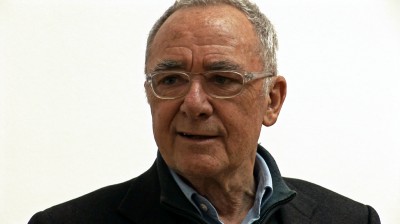
As seen in the period between 2008 and 2010 when Belz was accompanying him at work in his studio, to various meetings (with colleagues, agents, curators, etc.), and to public appearances, Richter is a very unprepossessing presence. Brief cuts to black-and-white interview footage of the artist as a young man in the rebellious '60s (especially so for him, as he was a defector from East to West Germany in the Soviet era, leaving behind forever his family and everything he'd known for the creative freedoms the West offered him, such as to create his own "capitalist realism" as a counterpoint to the "socialist realism" prescribed when working behind the Iron Curtain) reveal him to be somewhat more scornful, intimidating, and verbose at that time. In the present day, though, he's affable, serious but self-deprecating, quick to smile and laugh (and, though friendlier, unbelievably youthful for his current age of 79). The two close assistants briefly introduced and interviewed by Belz are reverent but not cowed; they seem to love their job (who wouldn't?), interacting freely with their boss and withholding their own opinions, not out of fear but because speaking too well too soon of Richter's work brings out a contrarian streak in him, reinforcing his omnipresent doubts and making it that much more likely he'll change or discard a picture that's otherwise going well. Some of Richter's other interlocutors -- art historian Benjamin Buchloh and American gallery owner Madeline Goodman, among others -- make for a more conversational atmosphere, but work in progress is something sacred, to be tread lightly around; it's the finished work, as more openly parsed by Richter and others, and as seen in beautiful panning shots that take in series of Richter's paintings from the past (the most visually elegant moments in the film), that can be discussed, after it's been realized and brought out of the jeopardy in which it always exists right up until that unpredictable moment when Richter knows it feels finished and looks the way it should.
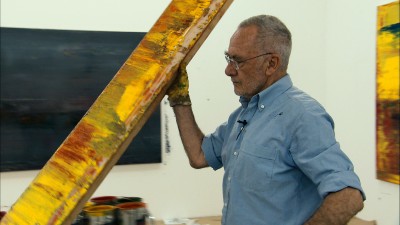
Richter's personality is nice but hearty, hardly fragile...except when he's facing that canvas. Belz's candid DV camera, whether handheld or in the more composed framings, lends an immediate presence to what we're seeing, very effectively conveying the fact that every move impacting a painting in progress, anything altering the texture or color or pattern (or lack thereof, if that's the goal) could be crucial, seismic, with much at stake; Richter must remain focused and careful at every moment. We can feel how taxing and painstaking his work is: At one point, in a close-up profile, we can see the physical effort it takes for him to stop visually dressing down what he's done, jerking his head away with a smile and insisting to himself, "No more looking for today." The whole process is seen in surprising fullness (and never described) -- not just the languorous (for us, not for him) medium-wide shots showing the application of the colors, the unusual planes and scrapers Richter uses to try to bring out the dynamic he wants from the piece, the moments of tense, still deliberation followed by a leap into action and a new stroke or modification added to the picture, but also the terrible moments of reckoning, where Richter assesses whether what he's done thus far is up to snuff, often deciding that he needs to regain perspective by giving his eyes a break from the work and returning to it with fresh eyes. It's at a particularly frustrated ebb, when he's decided what he's working on is failing, that we see Richter at his angriest, telling Belz that having the camera there and being watched is "impossible," an unnerving burden; even then, he's smiling sardonically, seemingly incapable of out-and-out harshness or rudeness.
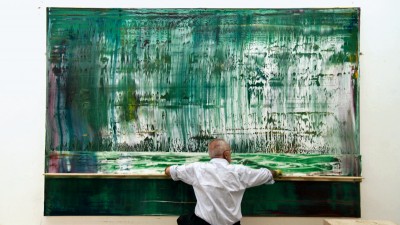
Anyone in search of psychology, gossip, cause-and-effect biography, or displays of tortured-artist neuroses, eccentricities, or tantrums is pretty much out of luck, then: We don't ever see Richter at home (though we do briefly meet his wife, a poised, elegant, somewhat younger woman who drops by her husband's workspace to say hello and casually offer her input, First Lady-like, before disappearing again), and though there are perusals of family photos (which Richter insists he views only as aesthetic objects) and matter-of-fact reminiscences about his art-school days, he cheerfully dismisses as "catchy stories" any psychoanalyzing hints he detects in the questions Belz poses from behind the camera about his childhood and what in his growing up might have led him to become a painter. In keeping with his concretely, immovably modern and forward-looking, intentionally difficult to "interpret" work, the film keeps the immediate, visible, solid life and being of Gerhard Richter front and center; its blunt but apt title very simply and forthrightly describes the most memorable and captivating thing it shows us, Mr. Richter in the act of painting, which is shown to be something quite complex and in its way very suspenseful, not simple or forthright at all. And it turns out, happily, that seeing Richter at work -- sometimes gamely playing along with the celebrity-artist rituals of meeting curators and attending openings, but much more importantly at his real work, when he becomes most alive, in the process of painting -- offers more than enough engagement and food for thought to render Belz's film a tumultuous, gripping experience, something to be drawn into, savored, and enthused over. Gerhard Richter Painting is a surprisingly visceral journey through the long, painful, joyous labor and delivery of works of art that aren't meant for getting to the bottom of, whose maker is seen here as someone for whom life is, at its most truly alive, painting. The film doesn't "explain" Richter at all, but it tells (shows) us in great detail what he would undoubtedly agree is the most relevant, important thing there is to know about him -- that much more than any personal history, anecdotes, or analysis of his psyche and personality, it is his work, both the act (the frightening and exhilarating process of making his paintings) and the attained result (the scores of challenging, captivating, highly-esteemed pictures that have made him one of the world's most famous and discussed painters), that is clearly as central to Gerhard Richter the individual as it is to Belz's film, and the only really meaningful, worthwhile, or true revelation of who he is.
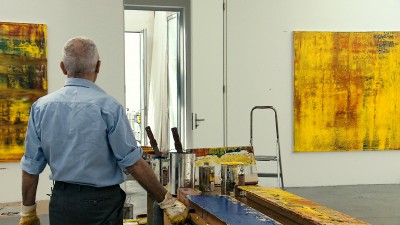
THE BLU-RAY DISC:
The AVC/MPEG-4/1080i transfer of the film, at a 1.78:1 aspect ratio, reflects the usual suitability of transition from digital video to digital media; the stark clarity of Belz's high-def DV images is preserved very well here, with perhaps one or two glancing instances of the slightest edge enhancement and some of the natural blur upon swifter camera movements that comes along with digital video of the grade used here. The picture quality overall is excellent; the colors of the paintings and the feel of the studio, gallery, and museum light are all solid, straightforward, and undistorted, fully rendering the visual experience intended by the filmmaker.
Sound:The DTS-HD Master Audio 5.1 surround soundtrack does a splendid job of conveying a sound design that is of a higher grade than expected for a documentary shot on digital video. Richter's workspace, for example, is sonically replicated through your speakers in all its echo-y cavernousness for a you-are-there quality that makes for an unusually important contribution to our complete immersion in the film. All sounds (mostly dialogue, but also the sounds of Richter's planing-and-scraping painting process, are clear, rich, and sonorous, with no distortion or imbalance at any point to distract from the experience at the aural level.
Extras:--The full 25-minute conversation between Richter and art historian Benjamin Buchloh excerpted in the film, in which the two discuss Richter's work in the context of different theories, philosophies, and zeitgeists of painting. For those unfamiliar with Richter's work or (like me) unschooled on painting frames of reference, it may work best to watch this before the main features; it's an excellent, enlightening primer.
--"Obrist Meets Richter" (10 min.), a 2007 short by Belz documenting a conversation between the painter and an art curator as they discuss how the eye responds to abstract painting, some of Richter's conceptual inspirations and work processes, and the importance of unpretentious exhibit titles.
--"Richter Prepares" (10 min.), in which the painter intensely but with obvious pleasure "directs" the proceedings, down to every detail of order and juxtaposition, as his works are installed in the exhibition space for his 2009 Munich "Abstract Paintings" show. Followed by a brief slideshow/montage of candid stills taken after the exhibit opened to the public.
--The film's theatrical trailer along with several other previews for Kino Lorber titles available on Blu-ray.
--Exclusive BD-ROM content (requiring a computer with a BD-ROM drive) includes director's notes/interview and an "About Gerhard Richter" informational supplement.
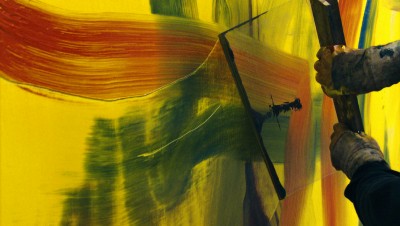
There's something innately fascinating about both the struggle for artistic creation and the "creative types" engaged in that struggle, whatever the medium, and as she gets us up close (almost intrusively so) to work in progress as it's being created by the renowned German abstract/photorealist painter Gerhard Richter, documentarian Corinna Belz -- who was given unprecedented access to Richter's studios and workspaces -- half gratifies, half further whets our curiosity about how art is made. Capturing the painter at work, in conversation, and in celebrity mode at gallery shows and exhibit openings (but, mostly, and by far most memorably, engaging in the physical process of laying paint onto canvas and making it conform to what his mind's eye sees), Belz comes as close as possible to somehow bridging that space between the artist's mind/spirit and the work itself, to visually depicting the mysterious process that goes on there. Richter is a very pleasant (if reticent) interview subject, with no scandals or juicy personal stories to tell, but there's something about that diffident personality that goes very smoothly with the man we see wordlessly and very energetically at work (one of the film's strongest, most intriguing revelations is just how physically laborious and painstaking painting is, at least the way Richter does it); if we're looking for the "real" Gerhard Richter, that's where it is, and that's what Belz is giving us the rare opportunity to see. The film goes far enough into archival footage of Richter and into the bare facts of his personal background for us to get the gist of his life's course, but this is not a biography, not even a professional one. Instead, Belz (with Richter's indispensable participation, which is clearly a graciously-borne burden for him at times) luxuriantly celebrates the tactile, concrete qualities of Richter painting, both in the ineffable pleasures of his finished work but, most of all, in what he does moment by moment as he sweats and fails and tries again to bring his canvases up to the standards of a vision only he can know, by his own sheer intuition, until he deems the painting complete. In letting us glimpse Richter's past victories and then rigorously, patiently, and closely examining his demanding, delicate process as the artist mounts the high wire once more to face new creative challenges, Gerhard Richter Painting goes well beyond just being informational or educational to become something that offers its own kind of gripping suspense -- a sort of action movie of the soul. Highly Recommended.
|
| Popular Reviews |
| Sponsored Links |
|
|
| Sponsored Links |
|
|
| Release List | Reviews | Shop | Newsletter | Forum | DVD Giveaways | Blu-Ray | Advertise |
|
Copyright 2024 DVDTalk.com All Rights Reserved. Legal Info, Privacy Policy, Terms of Use,
Manage Preferences,
Your Privacy Choices | |||||||









